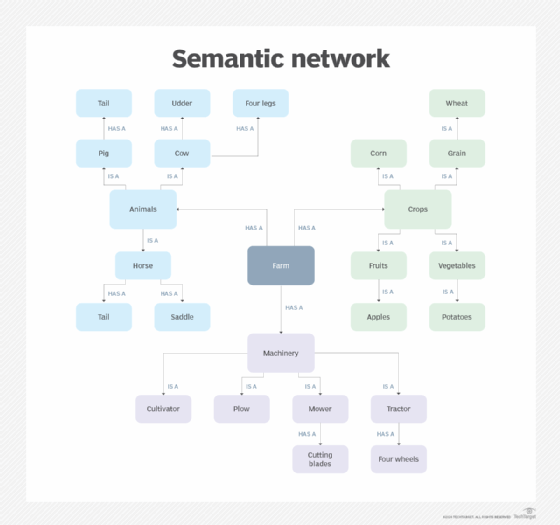What is a semantic network?
A semantic network is a knowledge structure that depicts how concepts are related to one another and how they interconnect. Semantic networks use artificial intelligence (AI) programming to mine data, connect concepts and call attention to relationships. In business, this capability provides better product search functionality, making customer service more effective. It can also help marketing and sales departments be more accurate when targeting new prospects.
Semantic networks largely work in the background of business processes and don't directly affect workers' daily lives. They can enhance a variety of functions and industries, including sales, marketing, retail and healthcare.
New technologies, such as Microsoft Graph and Microsoft Copilot, use semantic networking to bring related concepts together in the workplace. Such tools can, for example, use a worker's email to collect relevant documents for a meeting, connect the worker with employees who have helpful knowledge and even gather third-party data.
How does a semantic network work?
Semantic networks map out relationships between different concepts to represent knowledge in AI systems.
These networks create categories of known word relationships as synonyms and hyponyms. Hyponyms are words that have a more specific meaning than a related general term; for example, the word bird is a hyponym of the word animal.
This article is part of
What is GenAI? Generative AI explained
Semantic networks are constructed in a hub-and-spoke architecture and are made up of the following components:
- Nodes. These are objects and concepts that appear graphically as circles, ellipses or rectangles.
- Links. Also called arcs, these express the relationship between nodes using arrows.
- Labels. These further specify relations between concepts. Labels are placed on links and nodes.
- Bridge nodes. These nodes connect two different semantic networks. For example, the word farm could be a bridge node that connects nodes for different semantic networks, such as animals and crops.

The nodes, links and labels together form a graph wherein the relationship and meanings between different words are derived. Constructors and destructors are responsible for creating and removing links and nodes. Constructors set up the initial state of an object and destructors remove class objects.
Each link is labeled with descriptive factors, such as "is a" or "has a." These are two common types of labels, where "is a" shows that an object belongs to a larger category of objects and "has a" shows the characteristics of an object node.
This process helps AI systems to better understand the links between keywords that appear in text.
Examples of semantic networks in AI
Four real-world examples of semantic networks used in AI systems include WordNet, Gellish, SciCrunch and Google Knowledge Graph:
- WordNet. This English-based lexical database groups English words into synsets -- or sets of synonyms -- provides definitions and groups them into semantic networks.
- Gellish. The Gellish information representation language and knowledge base is used for expressing knowledge, facts, queries and answers.
- SciCrunch. A knowledge base of scientific resources, SciCrunch uses semantic data integration and information extraction techniques to assist biologists in generating hypotheses and explaining observed results from experiments.
- Google Knowledge Graph. Google uses its Knowledge Graph knowledge base to enhance search results with semantic search information gathered from various sources. It presents relevant facts, images and links related to the search query in the search results. The Knowledge Graph helps users find answers and discover related topics without having to click through to multiple websites.
Applications of semantic networks in various industries
Semantic networks find uses in various AI-enabled tools. For example, the Swiss Personalized Health Network (SPHN) is building an infrastructure based on the use and exchange of health data. To do this, the SPHN Data Coordination Center defines the semantics of the health data. The health data and related semantics are stored in a framework to cover the needs of health-related research projects.
Other implementations of semantic networks include the following:
- Answering queries. In AI programs designed to answer user queries, semantic networks help identify the relationships between different words and concepts in the input question.
- Chatbots. Chatbots commonly deal with inputs that use natural language. Semantic networks can help chatbots understand the meaning behind a user's input and provide relevant responses. However, not all chatbots need to use semantic networks.
- Data retrieval tasks. Semantic networks can be used in data retrieval software to help recover information from a large data set. In this setting, semantic networks identify the relationships between different words to find relevant information.
- Knowledge management. AI-enabled knowledge management tools help organize, store, manage and analyze data. Semantic networks provide a structured way to represent gathered data.
- Natural language processing. In NLP, semantic networks help map words and phrases to their related representations. This helps AI systems to grasp language meanings further.
Benefits of semantic networks
Semantic networks offer the following benefits:
- Simplicity. Semantic networks are easy to understand, making them a good technique for representing data.
- Space efficiency. Semantic networks are suited to optimizing storage requirements.
- Good organization. Semantic networks structure related data in a way that's human and machine-readable.
- Understandable meanings. Related words and concepts are easily representable to humans.
Challenges of semantic networks
Challenges that potentially come with implementing a semantic network include the following:
- Lack of inheritance. It's difficult for semantic networks to accurately pass characteristics from one data point to another.
- Limited to object links. Semantic networks can only represent binary object links, which limits possible relations.
- Lack of meta-knowledge. Semantic networks don't represent meta-knowledge well.
- Challenges of expressing specific properties. Different types of data properties, such as negation, are more challenging to show in semantic networks.
Semantic networks are used to uncover the relationships between different data points. Learn more about semantic networks, or knowledge graphs, and how they're used in databases to uncover new insights.








